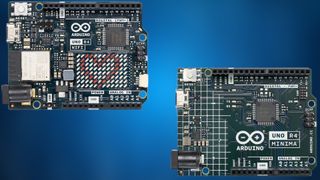Arduino Offers Up Two New Uno Boards
Featuring an ESP32-S3 co-processor

Arduino has announced its two latest boards, the Arduino Uno R4 WiFi and the Arduino Uno R4 Minima. As you can probably guess from the names, the R4 WiFi has onboard Wi-Fi, courtesy of an ESP32-S3 co-processor. The Minima features the same Arm Cortex M4 processor, but omits the ESP32-S3.
Could these boards surpass the $8 Raspberry Pi Pico W and $4 Raspberry Pi Pico? We'll find out when we get our hands on a unit for our review.
Arduino Uno R4 WiFi


The $27 Arduino R4 WiFi sees the familiar Arduino Uno layout but with a slight revamp. The layout remains the same, but instead of a large Atmel ATMEGA328P dominating the board, we see a 12 x 8 LED matrix. This matrix is used to show images and scroll text in much the same way as micro:bit. Replacing the 16 MHz ATMEGA328P microcontroller is a 48 MHz Renesas RA4M1 Arm Cortex-M4 CPU, providing an on-paper performance boost. How it will be reflected in your projects remains to be seen.
But the Arduino R4 WiFi is not just all about flashing lights. An onboard ESP32-S3, itself a competent microcontroller, provides both Wi-Fi and Bluetooth for the Uno R4 WiFi. This isn't the first Arduino with Wi-Fi, but it is a welcome addition to the R4, as IoT (Internet of Things) is clearly here to stay. As with many Arduino before it, the Uno R4 WiFi can also become a USB HID device, which means you can design your own inputs and use the Uno R4 as an interface. Custom keyboards, game controllers and assistive technologies are just a few lines of code, and a little soldering away.
An unusual but pleasant surprise is an onboard Qwiic connector. This connector is electrically compatible with many sensors and components using Adafruit's Stemma QT, Pimoroni's QW/ST and of course SparkFun's Qwiic connections. This means that you can easily connect up the best Stemma QT / Qwiic and QW/ST components for quick and simple projects.
| Microcontroller | Renesas RA4M1 (Arm Cortex-M4 @ 48 MHz) |
| Row 1 - Cell 0 | ESP32-S3 up to 240 MHz |
| Memory | RA4M1: 256 kB Flash, 32 kB RAM |
| Row 3 - Cell 0 | ESP32-S3: 384 kB ROM, 512 kB SRAM |
| GPIO | 14 x Digital I/O |
| Row 5 - Cell 0 | 6 x Analog inputs |
| Row 6 - Cell 0 | 1 x 12-bit DAC |
| Row 7 - Cell 0 | 6 x PWM |
| Row 8 - Cell 0 | 4 x UART, 1 x I2C, 1 x SPI, 1 x CAN |
| Row 9 - Cell 0 | 1 x Qwiic / Stemma QT / QWST Connector |
| Connectivity | Wi-Fi® support with 802.11 b/g/n standard (Wi-Fi 4) |
| Row 11 - Cell 0 | Bluetooth 5 |
| Power | 6-24V Input Voltage |
| Row 13 - Cell 0 | USB C |
| Row 14 - Cell 0 | 5V Logic level (ESP32-S3 is 3.3V) |
| Row 15 - Cell 0 | 8 mA DC current per I/O pin |
| Dimensions | 68.85 x 53.34 mm |
Arduino Uno Minima


If you don't need Wi-Fi or Bluetooth and fancy saving $7, then the Minima is the new base-level Arduino for your projects. Essentially, it's the same board as the Uno R4 WiFi, offering the same GPIO options, with the omission of the Qwiic connector. This omission is a great shame, but costs have to be cut to make the $20 price point.
| Microcontroller | Renesas RA4M1 (Arm Cortex-M4 @ 48 MHz) |
| Memory | RA4M1: 256 kB Flash, 32 kB RAM |
| GPIO | 14 x Digital I/O |
| Row 3 - Cell 0 | 6 x Analog inputs |
| Row 4 - Cell 0 | 1 x 12-bit DAC |
| Row 5 - Cell 0 | 6 x PWM |
| Row 6 - Cell 0 | 4 x UART, 1 x I2C, 1 x SPI, 1 x CAN |
| Power | 6-24V Input Voltage |
| Row 8 - Cell 0 | USB C |
| Row 9 - Cell 0 | 5V Logic level (ESP32-S3 is 3.3V) |
| Row 10 - Cell 0 | 8 mA DC current per I/O pin |
| Dimensions | 68.85 x 53.34 mm |
The Arduino Uno R4 WIFI and Arduino Uno R4 Minima are both available directly from Arduino.
Stay On the Cutting Edge: Get the Tom's Hardware Newsletter
Get Tom's Hardware's best news and in-depth reviews, straight to your inbox.
Les Pounder is an associate editor at Tom's Hardware. He is a creative technologist and for seven years has created projects to educate and inspire minds both young and old. He has worked with the Raspberry Pi Foundation to write and deliver their teacher training program "Picademy".
Most Popular






